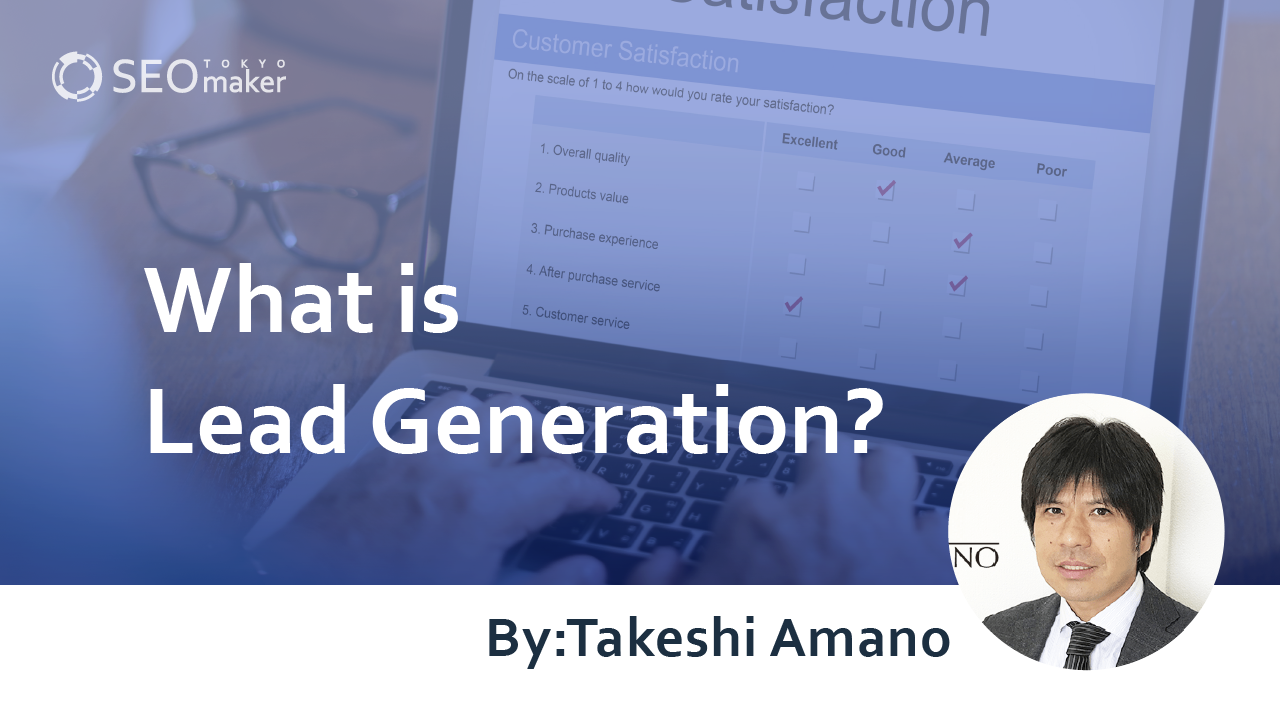What is Lead Generation? : Key points and Cautions
contents
- 1 What is Lead Generation?
- 2 Approach to Demand Generation
- 3 Key Points and Considerations for Successful Lead Generation
- 4 Using Marketing Automation (MA) for Lead Management
- 5 Frequently Asked Questions about Lead Generation
- 6 Summary

Lead Generation is a strategy aimed at acquiring potential customers as part of efforts to increase sales of B2B products. Lead Generation is conducted to secure prospective customers and ultimately leads to an increase in sales opportunities for sales representatives.
In this article, we not only explain Lead Generation but also delve into specific strategies, including related terms such as Lead Nurturing, to provide a comprehensive understanding of how to implement these initiatives.
What is Lead Generation?
Lead Generation refers to a series of marketing activities aimed at acquiring potential customers. ‘Lead’ refers to potential customers, and ‘Generation’ signifies acquisition. Furthermore, acquiring potential customers is referred to as ‘Lead Acquisition.’ Other terms closely related to Lead Generation include;
- Lead Nursing
- Lead Qualification
- Demand Generation
Difference from Lead Nursing
Lead Nurturing refers to the process of enhancing the relationship value between acquired leads and the company with the aim of converting them into customers. This involves providing valuable information to leads to build trust. Specific activities include;
- Providing souvenir talks during meetings or appointments
- Offering discounts or free trials of products or services
- Providing industry-related information through newsletters
After these activities, when the needs of the leads become apparent, they are passed on to the company’s sales representatives for further negotiations.
Difference from Lead Qualification
Lead Qualification involves the process of selecting potential customers with a high likelihood of closing a deal from acquired leads. For example, leads are scored on a scale of 1 to 5 based on internal criteria, and those with the highest scores, such as ‘5,’ are identified as leads with a high probability of closing a deal. These leads are prioritized for thorough Lead Nurturing activities.
When conducting Lead Qualification, the following factors are analyzed to scrutinize and prioritize leads.
-Compatibility of our products with the challenges faced by the client company (impressions and needs related to our product)
-Budget prepared for purchasing products or services (purchasing power towards our products)
-Value of relationships built through lead nurturing (impression towards our company and representatives)
Difference from Demand Generation
Demand Generation refers to a series of initiatives aimed at creating new sales opportunities. Specifically, it encompasses the following three flows.
- Lead Generation: Acquiring potential customers
- Lead Nurturing: Cultivating potential customers
- Lead Qualification: Selecting potential customers with high certainty
Therefore, Lead Generation is positioned as part of Demand Generation.
Approach to Demand Generation
The approach to Demand Generation varies depending on the company’s position and objectives. For example, if a company’s media or advertising agency aims to strengthen ad space sales, Demand Generation would involve increasing the number of cases leading to negotiations. Let’s explain the flow for this using specific examples.
1. Methods of Lead Generation
2. Methods of Lead Nurturing and Lead Qualification
Methods of Lead Generation
First, lead generation is conducted to gather potential customers. Initially, industries or companies that may potentially purchase ad space offered by the company are identified. To acquire leads, it is necessary to make contact with stakeholders of potential client companies. Once the target is narrowed down, actions for lead acquisition are determined. The methods mainly include the following activities.
- Prospecting through visitations
- Attending events or networking to exchange business cards
- Providing assistance to inquiries from external sources through the company’s website or social media
Prospecting through visitations
In sales activities, targets are first listed, and an appointment list for sales visits is created. In creating the list, information on new products and financial statements of the targets are checked via the internet. Hypotheses are then formed regarding the timing when the promotion of new products is likely to be strengthened. Considering the compatibility with the advertising products the company sells, if there is a match, the targets are added to the list.
Once appointments are scheduled, criteria for checking during visits are predetermined. The main points to confirm during visits include;
- Information on new products and challenges (compatibility with ad space sold by the company)
- Advertising plans (availability of advertising budget)
- Position of the person in charge during negotiations (authority to make decisions)
Understanding the challenges faced by the visiting company is particularly important. By doing so, information from the visiting company is absorbed, and it is then added to the appointment list.
Attend Events and Networking Sessions for Business Card Exchange
Industry-specific events and networking sessions are often held. Actively participating in these events helps to build connections within the industry. By exchanging business cards with industry professionals at event venues, many business conversations can unexpectedly unfold.
Furthermore, it is essential to visit the booths of companies with which you have connections at such events. From the perspective of companies hosting the booths, seeing someone from another company takes the effort to attend the event leaves a positive impression. For booth representatives, attracting visitors to their booths is a mission, and this interaction can serve as a foundation for establishing mutual trust.
Assisting External Inquiries via Company Website
By setting up pages introducing advertising products or inquiry forms on the company’s media or website, an environment is created for targets interested in advertising products to contact the company. Additionally, sharing the company’s expertise in blog format and distributing it can increase the number of inquiries. This approach is called inbound sales, where these inquiries are then converted into sales opportunities.
In inbound sales, proactive inquiries directly contribute to acquiring potential customers. Specific inquiries may range from simple requests for information to cases directly leading to discussions about advertising products.
Methods of Lead Nurturing and Lead Qualification
Once leads are acquired, lead nurturing strategies are implemented. The goal of lead nurturing is to build a relationship between the company and the lead. In this strategy, it’s crucial to present the benefits of associating with the company to the lead company. Actions for this purpose include;
- Providing information to lead companies
- Offering advertising samples or free trials
Additionally, lead qualification is carried out concurrently to organize cases with high chances of conversion.
-Organizing Lead Information
Moreover, it is beneficial to meet with individuals holding decision-making authority beforehand to facilitate smooth negotiations for the sales department.
-Meeting with Individuals Holding Decision-Making Authority in Lead Companies
Provide Information to Lead Companies
For instance, if a lead company is gearing up for the launch of a new product, they are likely engaged in marketing activities to promote it. In such cases, lead companies aiming to make the new product launch successful are seeking methods and information. The valuable information that lead companies seek includes;
- Success stories of similar products in the same industry
- Cost-effective promotional strategies
- Information on excellent advertising products
- Performance data of advertising products
- Information on competitors’ new products or advertising strategies
When you have access to such information, sharing it during meetings or other interactions is appreciated. Moreover, it helps create an impression of being someone with whom it’s beneficial to maintain a relationship.
Offer Samples or Free Trials
When lead companies are conducting marketing activities to sell new products, they may be looking for test cases as part of their research. In such cases, providing services using your own products, such as;
- Offering a free trial of advertising products
- Presenting samples of advertising products
For the former, if the client company achieves positive results in their efficacy tests, they may consider purchasing the advertising material. In the latter case, by viewing a sample, for instance, the client company can develop a concrete image of the actual article advertisement. If the sample is evaluated favorably in terms of creative quality, it might move to the consideration phase for purchase.
Organize Lead Information
Once information such as the number of leads and the challenges faced by lead companies starts accumulating, it is essential to organize the lead information using tools like Excel. Specifically, we will compile the following elements into the lead information.
- Department and position of the contact person met with the prospective customer
- Challenges faced by the prospective customer
- Information about the new product and its release date
- Budget allocated for the advertising campaign of the new product
- Probability of closing the deal based on internally set criteria
Using this information, you will proceed with lead qualification to select customers with high purchasing intent. Going through this process makes it easier for sales representatives to set up meetings and increases the likelihood of successful negotiations.
Meet with Key Decision-Makers in Leading Companies
For example, if you want to sell your advertising products, you generally exchange information with the advertising or marketing departments of lead companies. However, the individuals primarily responsible for deciding to purchase your products are usually the heads of the advertising or marketing departments, or even executives. Since these positions decide on advertising spending, obtaining their contact information in advance facilitates smoother negotiations and contract closures for sales representatives.
Key Points and Considerations for Successful Lead Generation
The purpose of lead generation is ultimately to increase potential customers. To successfully generate potential customers, keep the following points in mind.
-Quickly capture target information.
-Gain industry knowledge to build credibility.
-Provide valuable information through appropriate means.
Quickly Capture Target Information
Potential customers typically have challenges they want to solve. With the widespread use of the internet, information and situations change rapidly. In such a scenario, potential customers want to resolve their challenges as soon as possible. By quickly capturing target information and challenges, you create a situation where you can propose optimal solutions. Conversely, delayed action may lead to the followings.
- Challenges being already resolved
- Competitors taking the lead in implementing solutions to the challenges
This could lead to the disappearance of needs and result in missed opportunities, so strive for prompt action.
Acquire Industry Knowledge to Gain Trust
As part of lead acquisition, activities such as visiting companies for interviews are common. When greeting during company visits, it is typical to engage in small talk, including discussions about the industry.
In these situations, your knowledge and experience in the industry are crucial. You need to give the impression of being knowledgeable about the industry. Conversely, if you are perceived as not being knowledgeable about the industry, you might not get detailed information about the challenges faced by the visited company. To avoid this, make an effort to acquire information and knowledge about the industry.
Provide Valuable Information in Appropriate Way
The valuable information to provide to potential customers and the methods of communication vary depending on the situation. The goal here is to share information in a way that the potential customer will appreciate. Some specific methods include;
- Company visits
- Hosting seminars
- Email newsletters
- Phone or video calls
- Press releases
Using Marketing Automation (MA) for Lead Management
The goal of demand generation is to create opportunities that lead to sales. In the process of advancing demand generation, there arises the task of managing lead opportunities. A tool called Marketing Automation (MA) is helpful for this purpose. Let us introduce some specific functions of MA.
Lead Acquisition Management
There is a function to manage acquired lead information. Normally, information that is managed in a distributed manner can be centralized. The lead information that can be managed includes;
- Business card information obtained during visits
- Obtaining business card information through inbound activities
- Access history of company product pages
- Number of times company product materials have been requested
- Past transaction records
Scoring of Certainty
When sorting the priority of leads, lead qualification is carried out. For this purpose, it is convenient to visualize the certainty as a score. MA has a function for scoring certainty. The specific scoring method involves entering conditions set within the company into the tool, which then automatically assigns scores. When managing a large number of leads, manual work has its limits, so using this feature can improve efficiency.
Frequently Asked Questions about Lead Generation
Here are some common questions about lead generation.
Q: What is the difference between lead generation and sales activities?
Answer: Lead generation aims to acquire potential customers, so it involves preliminary research by sales staff to initiate negotiations and close deals. Even if you skip the lead generation process and focus on new developments, it doesn’t often lead directly to negotiations. Additionally, nurturing relationships through lead nurturing before ‘selling’ has its advantages.
Q: Which department is responsible for lead generation within the company?
Answer: Lead generation is a marketing activity carried out to increase sales opportunities, so the marketing department is responsible for it. However, depending on the company’s organizational structure and the strengths of its employees, other departments may handle it flexibly. Lead generation and lead nurturing primarily involve building relationships between the company and external parties. Therefore, employees who excel in social skills and external consultations and negotiations are suitable.
Summary
Lead generation is an activity aimed at increasing potential customers. It nurtures a good relationship with acquired lead companies. To build relationships with potential client companies, the primary means used are providing valuable information. Ultimately, the responsibility shifts to the sales staff for closing the deal. If your company aims to increase sales opportunities, consider implementing demand generation strategies, including lead generation.
Top of Form










![What is a Description? Explaining the Meaning, Writing Style, and Changing Word Count – [2023 Edition]](https://www.switchitmaker2.com/en/wp-content/uploads/2024/09/what-is-description.webp)










